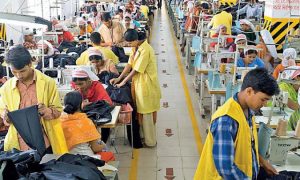
Pakistan’s economy is on the brink of bankruptcy like Sri Lanka’s. Pakistan’s foreign exchange reserves have fallen below $3 billion. They have asked the IMF for a ‘bailout loan’ a long time ago, but the IMF is trying to impose strict conditions that Pakistan’s current ruling coalition has no capacity to meet. Even China and Saudi Arabia, Pakistan’s long-standing loyal friends, are now reluctant to shoulder Pakistan’s burden.
China has stopped power supply from the power plants built by Pakistan on China’s loan after Pakistan failed to pay the long-delayed instalments. Due to this terrible load shedding is going on all over Pakistan. Frequent grid failure. The value of the dollar in Pakistani rupees has increased dramatically, currently Pakistan has to pay 277 rupees to get 1 dollar.
Inflation in Pakistan’s economy has reached such an alarming level that the price of a kg of flour now exceeds Rs 160 and a kg of sugar is over Rs 300. The main reason for this crisis is the burden of a huge armed force of seven lakhs including five and a half lakh army. It is not economically feasible for Pakistan to raise such a large army just for war with India.
Hostilities between the two countries began with the Kashmir War of 1947-49, which ended with a UN-imposed ceasefire. Although the 1965 war was not decided by either side, the diplomatic victory in the war that was settled by the Tashkent accord went to India.
In the 1971 war, the Pakistani armed forces surrendered in Dhaka after being defeated by the Bangladesh-India joint forces, through which Bangladesh declared independence on 26 March 1971 and marched in victory on 16 December. In the last Kargil war of 1999, Pakistan was forced to accept a ceasefire that failed to achieve its objective.
But as an inevitable consequence of this war game, the actual governance of the Pakistani state came from behind the scenes in 1948-58 and directly in the hands of the military establishment in 1958-71.
In the current phase, Imran Khan came to power through the election as a favorite of the military, but within a few years, due to power struggle with the army chief Qamar Bajwa, no one had any difficulty in understanding that the military establishment was also behind the installation of Shahbaz Sharif after ousting him a few days ago. ISI, the intelligence agency of the armed forces of Pakistan, is playing a role as a powerful tool of the military establishment in this power grab game.
In 2005, the military economy became a major force in Pakistan’s economy, with four armed forces-created organizations, the Fauji Foundation, the Army Welfare Trust, the Shaheen Foundation and the Baharia Foundation, becoming the country’s four largest business and industrial enterprises.
Since 1948, the defense sector has been the main sector of the budget of the government of Pakistan, from which the sector could not be removed even in the last 75 years. There is no doubt that any government in Pakistan has the audacity to put its hands on the budget.
“Per capita GDP of Bangladesh in 1971 was 60% less than that of West Pakistan.
But in 2015, it surpassed that of Pakistan.”
- In terms of per capita GDP, Bangladesh has surpassed Pakistan by 80 percent. Bangladesh’s per capita GDP in 2021-22 is $2793 and Pakistan’s is $1547.
- Bangladesh’s export earnings are more than double that of Pakistan’s, exceeding $52 billion in FY 2021-22.
- Bangladesh’s foreign exchange reserves reached $48 billion in August 2021, declining over the past 17 months to $24 billion in January 2023 as per IMF calculations, more than eight times Pakistan’s. (According to the Bangladesh government’s account, the reserve of Bangladesh is 32 billion dollars).
- The average life expectancy of the people of Bangladesh is 73 years, 66 years in Pakistan.
- The literacy rate of the people of Bangladesh is 76 percent, while that of Pakistan is 59 percent.
- The total GDP of Bangladesh is 465 billion dollars, and that of Pakistan is 346 billion dollars.
- Population growth rate of Bangladesh is 1.2 percent and Pakistan is 2.1 percent. As a result, the population of Pakistan has increased to 22.5 million, and the population of Bangladesh is 16.98 million.
- 1 dollar is available for maximum 107 taka in Bangladesh, 277 rupees to buy 1 dollar in Pakistan. But till 2007 the foreign exchange value of rupee was 8 percent higher than taka.
- Bangladesh’s total foreign debt is 20.48 percent of GDP, while in Pakistan it is 46 percent of GDP.
- 36 percent of women in Bangladesh work outside the home yard, compared to only 14 percent in Pakistan.
- In Bangladesh the infant mortality rate is 21 per thousand, and in Pakistan it is 59.
- 100% population of Bangladesh is covered by electricity facility, while 73% population of Pakistan is getting electricity.
The above data shows that Pakistan will never catch up with Bangladesh in the race of economic development. The GDP growth rate of Bangladesh increased gradually to 8.13 percent in the fiscal year 2018-19. In 2020-22, the impact of the novel coronavirus pandemic and the Russia-Ukraine war slowed down the growth rate of Bangladesh, but it was much higher than that of Pakistan and the growth rate is estimated to exceed 6.5 percent again in the fiscal year 2022-23.
Development thinkers are optimistic that the economy of Bangladesh, a low-middle-income country, will rise to the upper-middle-income category very quickly if harmful activities like corruption, looting and money laundering are strictly controlled. But for this, the root problems like corruption, looting and money laundering need to be tackled properly.
—
*Independent researcher and freelance columnist, Dhaka
Source- counterview.net , March 9, 2023.



